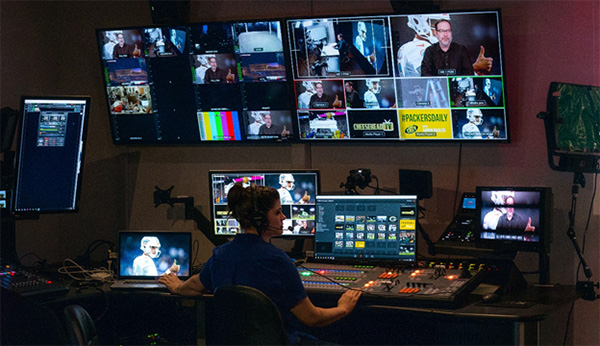Creating Interaction for the Social Distancing Era With Live Streaming
By Kirsten Nelson
 Live X will deliver live event streaming for the Columbia University Irvine Center commencement ceremony this spring.
Live X will deliver live event streaming for the Columbia University Irvine Center commencement ceremony this spring.
A certain amount of technical forgiveness is easily granted to new live streamers who are delivering access to the world during a time when the pandemic keeps us at home. The occasional crooked camera angle and even a laggy feed are just minor glitches to overlook in the greater picture of feeling some semblance of connection with what lies beyond our doors.
But as demand for live streaming endlessly increases, and many in the AV industry are asked to provide these services for clients across verticals, it might be time to review the fundamentals of putting on an internet show.
If there’s someone who knows how to make live streaming engagingly fun on the front end and impressively technical behind the scenes, it’s Corey Behnke, Producer and Founder of Live X, a full-service design, production, and broadcast company. Speaking from the Live X studio, which is operating as an essential service on the west side of Manhattan, Behnke provided some tips for making a live stream more than just another web chat.
Previous to the pandemic, remote broadcast represented about 10 percent of Live X’s business, Behnke notes. “It is now about 99 percent of our business, obviously.”
Providing essential video production and delivery services for major media clients including Axios, and also mission-critical healthcare facilities like Montefiore Medical Center, Live X will also be innovating live event streaming for the Columbia University Irvine Center commencement ceremony this spring.
With so many different types of live streams happening now, here are a few things that apply across the board:
Remember, Live Means Interactive — “The whole reason to do something live is to be interactive,” Behnke emphasizes, “otherwise, you might as well tape it, edit it, and put it on YouTube, because it's going to look better, you know?”
 Live X is experimenting with new types of interactive components such as live trivia with an audience response leaderboard.
Live X is experimenting with new types of interactive components such as live trivia with an audience response leaderboard.
Interactivity can be as simple as asking for input via social media, which can actually lead to some pretty creative programming. Like when Live X put a snowman in its studio for a New York Lottery promotion and asked Facebook viewers to help dress it, and later to choose which heater to use to melt it. “It got huge engagement, crazy engagement,” Behnke said.
Live X is also experimenting with new types of interactive components, using its own Cheesehead TV production as a sort of beta testing scheme. For a new Cheesehead TV trivia game, Live X is using a custom-built YouTube API in conjunction with a chat function integrated with its own streaming platform, which is built on Wowza. Audience responses are used to drive clever graphics-based features and their scores are tracked with a leaderboard.
More advanced interactivity can be added with platforms like Pulse IO, which provides functionality for Q&As and polls. Then there are options for audience submitted photos, raffles, emotional response technology, resource downloads, and word clouds.
All of these happen to be features within the Live X platform, but Behnke says, “with a little bit of JavaScript, really anybody can build these tools. And they're fairly inexpensive.”
 Even after we emerge from isolation, many of these live streaming practices will come in handy for the new realm of social-distancing-friendly events.
Even after we emerge from isolation, many of these live streaming practices will come in handy for the new realm of social-distancing-friendly events.
Remote Contributor — First, the basics. Upgrade to a decent HDMI camera and get that signal into your computer using something like the Magewell HDMI into USB capture device.
Other things you might want to add to your live streaming toolkit:
- vMix — Using any one of the webconferencing platforms that runs on WebRTC with vMix switching software enables all the production tricks that enhance the viewing experience. Plus with vMix Call it’s easy for remote contributors to join in via a simple link, through which they can also see a program view so they know what’s going out to audiences. As a backup, Behnke suggested adding Skype into a workflow, as it can be a good fallback option when network congestion is an issue (which it often is in these times of everybody working from home).
- SRT — SRT is an open-source protocol developed by Haivision and Wowza. It’s codec-agnostic, unhackable, and it operates over UDP instead of the more commonly used TCP/IP, which means operators can trade between latency and reliability and get higher quality at lower bandwidth. SRT can now be used with vMix and OBS, which according to Behnke, is “everybody’s favorite program right now.”
- Intercom — Connect all your remote team members and talent using intercom from a manufacturer like Clear-Com or try the new low-cost, low-latency, server-and-app-based option from Unity. “What's awesome about Unity is you can actually mix music live,” Behnke notes, pointing to applications where you want to have musicians doing 64 tracks of audio. Gamers will note that you can tie Discord in with Unity as well.
What's on Next?
Even after we emerge from isolation, many of these live streaming practices will come in handy for the new realm of social-distancing-friendly events. So, it’s essential for broadcast, AV, and event content producers to keep innovating. Because today’s particular version of a captive audience definitely wants to see something beyond a standard video chat when they tune in for a live event.
Using Extended Reality to Engage and Inspire Your Streaming Audience: Watch Emerging Video Trends for Live Events to hear from Peter Harding, Head of Creative Technical for Hawthorn, as he shares three real-world examples of streamed events that used extended reality to enhance the streaming event experience. Scott Frankel, President of Animatic Media, also discusses online video trends for corporate events including virtual event platform best practices.





